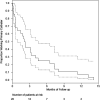Patency and Complications of Translumbar Dialysis Catheters
- PMID: 25800550
- PMCID: PMC4836066
- DOI: 10.1111/sdi.12358
Patency and Complications of Translumbar Dialysis Catheters
Abstract
Translumbar tunneled dialysis catheter (TLDC) is a temporary dialysis access for patients exhausted traditional access for dialysis. While few small studies reported successes with TLDC, additional studies are warranted to understand the short- and long-term patency and safety of TLDC. We conducted a retrospective analysis of adult patients who received TLDC for hemodialysis access from June 2006 to June 2013. Patient demographics, comorbid conditions, dialysis details, catheter insertion procedures and associated complications, catheter patency, and patient survival data were collected. Catheter patency was studied using Kaplan-Meier curve; catheter functionality was assessed with catheter intervals and catheter-related complications were used to estimate catheter safety. There were 84 TLDCs inserted in 28 patients with 28 primary insertions and 56 exchanges. All TLDC insertions were technically successful with good blood flow during dialysis (>300 ml/minute) and no immediate complications (major bleeding or clotting) were noted. The median number of days in place for initial catheter, secondary catheter, and total catheter were 65, 84, and 244 respectively. The catheter patency rate at 3, 6, and 12 months were 43%, 25%, and 7% respectively. The main complications were poor blood flow (40%) and catheter-related infection (36%), which led to 30.8% and 35.9% catheter removal, respectively. After translumbar catheter, 42.8% of the patients were successfully converted to another vascular access or peritoneal dialysis. This study data suggest that TLDC might serve as a safe, alternate access for dialysis patients in short-term who have exhausted conventional vascular access.
© 2015 Wiley Periodicals, Inc.
Figures



References
-
- United States Renal Data System . Annual data report: atlas of chronic kidney disease and end-stage renal disease in the United States. National Institute of Diabetes and Digestive and Kidney Diseases, National Institutes of Health; Bethesda, MD: 2013. 2013.
-
- Excerpts from the United States Renal Data System 1996 annual data report. Am J Kidney Dis. 1996;28:S1–165. - PubMed
-
- El-Sabrout RA, Duncan JM. Right atrial bypass grafting for central venous obstruction associated with dialysis access: another treatment option. J Vasc Surg. 1999;29:472–478. - PubMed
-
- Chemla ES, Korrakuti L, Makanjuola D, Chang AR. Vascular access in haemodialysis patients with central venous obstruction or stenosis: one center's experience. Ann Vasc Surg. 2005;19:692–698. - PubMed
-
- Murthy R, Arbabzadeh M, Lund G, Richard H, Levitin A, Stainken B. Percutaneous transrenal hemodialysis catheter insertion. J Vasc Interv Radiol. 2002;13:1043–1046. - PubMed
Publication types
MeSH terms
Grants and funding
LinkOut - more resources
Full Text Sources
Other Literature Sources
Medical

